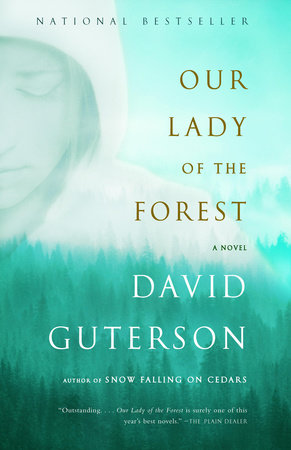Our Lady of the Forest Reader’s Guide
By David Guterson


1. The book’s opening echoes the tone of official reportage, using “the girl” instead of naming Ann Holmes. Elsewhere in the narrative Ann is called “the visionary.” Why? Does this create a sense of distance from her? Does the narrative tone of voice, as well as the narrator’s stance, shift throughout the novel? Is the tone of objectivity about the events and characters maintained?
2. What role do sexuality and sexual desire play in this story, particularly for Tom Cross, Father Collins, and Ann? What attracts Father Collins to Ann [p. 38]? Are beauty, sexual desire, violence, and victimization interrelated in this novel? If so, how?
3. Does Guterson expect his readers to believe that Ann’s encounters with the Virgin Mary are real? Does he seem sympathetic to the position of Father Collins, who is skeptical and yet open-minded, or of Carolyn, who is entirely analytical and cynical about the visions? Is there a character with whom readers are most likely to identify? Who is it?
4. What kind of person is Carolyn Greer? Is she an opportunist, an intellectual, a cynic, an actor, a thief? If she is talented and intelligent, why is she living in a campground in North Fork? Is she a more intriguing character than Ann?
5. Why did Father Collins decide to become a priest? Does the priesthood solve his personal dilemmas? Does he have the necessary qualities of leadership to be a priest? A year after Ann’s death, what effect have Ann’s visions and their aftermath had on Father Collins? Has he become a better priest or a wiser person?
6. What does the extended passage in which Tom Cross thinks about his family life, and particularly his son, tell us about him [pp. 96–105]? Is Tom Cross responsible for the accident that paralyzed his son? With his anger, desperation, and self-loathing, how dangerous is he? Is there anything admirable or positive about him? How does he change?
7. How does Guterson evoke the unique locale of the Pacific Northwest, with its local economy that pits loggers against “jogging-shoed, tree-hugging, latte lovers” [p. 107]? In what ways does he evoke the feeling of life in a rainy, foggy place? How important is the setting to the story, in terms of the local economy, weather, and landscape?
8. Is there any connection between Ann’s visions and the fact that she has been repeatedly raped by a drug addict who was obsessed with religion [pp. 131–32]? Does the novel suggest that her devotion to the Virgin results from a need to cleanse herself of her own past and to make amends for the abortion she had [p. 133]?
9. The narrator shares with readers the information that Ann is a victim of violent sexual abuse; this fact is not made known, however, to Father Collins or to the public, and so it is not a factor in the inquiry into her case. What are the effects on the reader of knowing Ann’s history?
10. How relevant to her credibility is the fact that Ann wasn’t raised as a Catholic, like Bernadette at Lourdes or the children at Fátima? Do her followers care? Is this a story about Catholicism or about a larger phenomenon in America today? What is Guterson suggesting about religious faith or about the need for it?
11. Father Collins and Father Butler know that Ann has used psilocybin mushrooms, and this leads them to suspect that her visions are hallucinogenic flashbacks [pp. 285–87]. The evidence gathered by Carolyn, however, points to side effects of the allergy medication Ann habitually used. How does Father Collins respond to Carolyn’s outrage when she realizes that “Phenathol’s behind this massive spectacle. This multimillion-dollar film-set church” [p. 321]? Given their conversation, what is the effect of the novel’s final scene [pp. 322–23]?
12. Does Guterson suggest that there is a point at which hysteria and faith overlap? What are readers to make of the thousands of believers who come to North Fork to follow Ann to the site of her visions? What does Guterson suggest about the psychology of large groups and the behavior of crowds [pp. 136–48]?
13. Why does Carolyn come back to visit North Fork for the opening of the church [p. 316]? What effect do Ann’s followers, and the eventual building of the church, have upon the area’s economy?
14. What is the meaning of the Virgin’s dire warnings and of the urgency of her message to Ann? How should readers interpret this aspect of Ann’s vision, as well as Ann’s fear of Satan?
15. There are often moments of humor in Our Lady of the Forest. What incidents or descriptions are particularly funny? What sort of humor do they exemplify?
16. To what extent does Guterson emphasize Ann’s position as a child who is essentially uncared for and homeless, a victim of her mother’s neglect? How important are the social issues that brought Ann to North Fork in the novel? Does Ann’s obsession with the Virgin Mary reflect her need for a caring mother?
17. The novel builds to a climactic scene in which Tom Cross confronts Ann in the church [pp. 300–10]. What are the dynamics of the scene? What does Tom Cross want from Ann, and how close to violence is he? Why does Carolyn intervene as she does?
Just for joining you’ll get personalized recommendations on your dashboard daily and features only for members.
Find Out More Join Now Sign In